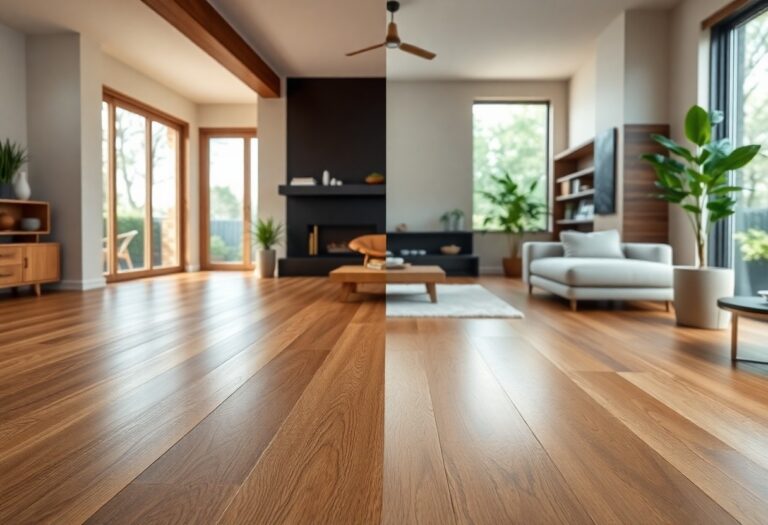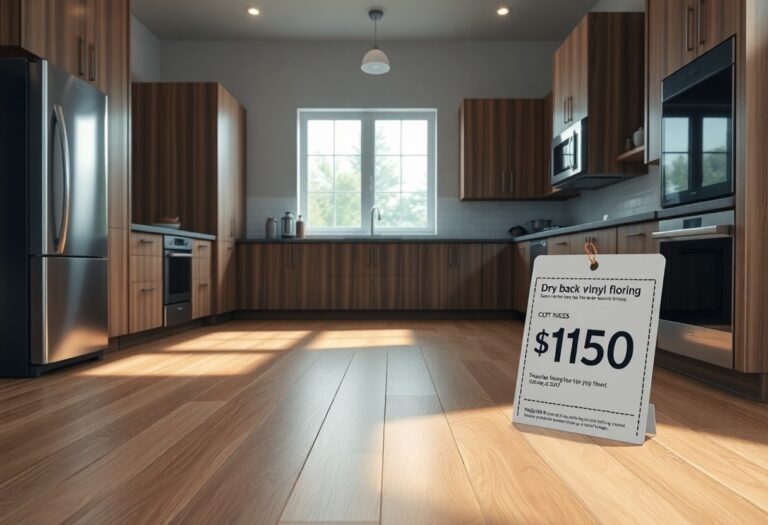Dryback vinyl flooring offers a durable and cost-effective solution for your home, particularly in Kitchener’s diverse climate. As you consider flooring options, it’s important to weigh the benefits of dryback vinyl against alternatives like laminate, carpet, and tile. This guide will help you make informed decisions, highlighting the unique features, maintenance requirements, and aesthetic appeal of each type. By the end, you’ll have the knowledge needed to choose the flooring that best suits your needs and lifestyle.
The Aesthetic Appeal of Dry Back Vinyl
Dry back vinyl flooring offers an appealing blend of beauty and functionality, perfect for kitchens looking for style without sacrificing performance. With a wide range of colors, patterns, and textures, this flooring option can suit various design preferences, enhancing the overall ambiance of your space. You’ll find options that mimic natural materials like wood and stone, giving your kitchen an upscale look while remaining budget-friendly.
Design Versatility: From Modern to Rustic
This flooring adapts effortlessly to diverse styles, from sleek, contemporary environments to cozy, rustic kitchens. You can select finishes that emulate reclaimed wood or bold, geometric patterns that add a modern edge. This versatility allows your flooring to complement existing décor seamlessly, making it a practical choice for any aesthetic vision you have in mind.
Surface Texture: Feeling Authentic While Remaining Practical
Dry back vinyl includes a range of surface textures that enhance realism without compromising durability. You can feel the difference as the texture mimics traditional materials, offering a tactile experience that elevates your kitchen’s atmosphere. Moreover, these surfaces are designed to withstand daily wear and tear, ensuring longevity without the maintenance challenges found in genuine wood or stone.
The layered structure of dry back vinyl features embossed textures that reproduce the grain and knots of natural wood, creating an authentic appearance that appeals to your design sensibilities. Additionally, this textured finish provides traction, reducing slip hazards in areas prone to spills, making it ideal for kitchens. The low-maintenance requirement, combined with the aesthetic charm of authentic-looking materials, positions dry back vinyl as a smart flooring solution that doesn’t compromise on style or practicality.
Performance Metrics: Durability and Maintenance
Assessing durability and maintenance is vital for choosing the right flooring. Dry back vinyl flooring excels in high-traffic areas like kitchens, providing both robust performance and ease of upkeep. Its resilience against scratches, dents, and regular wear ensures longevity, requiring minimal maintenance to keep it looking fresh.
Resistance to Water and Stains: A Kitchen Must-Have
Your kitchen demands flooring that can withstand spills and messes. Dry back vinyl boasts excellent water resistance, preventing moisture from seeping in and causing damage. Additionally, its stain-resistant surface allows for easy cleanup of food and beverage spills, making it an ideal choice for busy households.
Lifespan Comparison: How Long Will It Last?
Dry back vinyl flooring typically lasts between 10 to 20 years, depending on usage and maintenance. In comparison to other flooring options, its lifespan is competitive, especially considering its lower maintenance requirements and durability under daily wear. Options like laminate might last slightly longer, but dry back vinyl’s combination of water resistance and stain protection makes it a favorite for kitchens.
Lifespan Comparison: How Long Will It Last?
| Type of Flooring | Average Lifespan |
| Dry Back Vinyl | 10-20 years |
| Laminate | 10-25 years |
| Tile | 20-30 years |
| Hardwood | 30-100 years (with refinishing) |
Choosing dry back vinyl means balancing lifespan with practicality. While hardwood and tile may outlast it, their installation and maintenance costs are often higher. With dry back vinyl’s affordability and resistance to daily kitchen challenges, its longevity offers a smart investment for your space.
Installation Insights: Navigating the Process
Understanding the installation process for dry back vinyl flooring can save you time and money. Familiarize yourself with the recommended subfloor preparation, as a clean, dry surface is crucial for optimal adhesion. Proper acclimation of the planks before installation is also key to preventing future warping or buckling. Additionally, measuring your space accurately helps in minimizing waste and ensuring a smoother installation experience.
DIY-Friendly Features: Tools and Tips for Easy Setup
This flooring option is designed for ease of installation, making it ideal for DIY enthusiasts. You’ll only need a few basic tools such as a utility knife, straightedge, and a roller for proper application. Key tips include ensuring the subfloor is level and dry, allowing planks to acclimate, and working in small sections for best results.
- Create clear measurements before cutting planks.
- Use a rolling pin for better adhesive contact.
- Keep your workspace organized to streamline the process.
- Thou should embrace patience, as careful installation pays off.
Professional Installation: Costs and Benefits
Opting for professional installation ensures precision and can save you hassle and time. Typically, costs average between $2 to $5 per square foot depending on the complexity of the job and local labor rates. Professionals bring expertise in handling subfloor issues, ensuring proper alignment, and guaranteeing a seamless finish. Additionally, most installers offer warranties on their work, providing peace of mind against installation-related issues.
Budgeting for Flooring: Evaluating Cost-Effectiveness
Choosing flooring involves not just the price tag but also the overall value it brings to your space. Balancing upfront costs with long-term benefits can make a significant difference in your budget. For instance, while dry back vinyl may have a higher initial price than laminate, its durability and lower maintenance may save you money over time. Evaluating these factors will help you make a more informed decision.
Upfront Costs vs. Long-Term Value
Calculating your flooring budget should start with understanding upfront costs, which include material prices and installation fees. However, long-term value, such as durability and ease of maintenance, must also influence your choice. Dry back vinyl flooring typically has higher wear resistance compared to options like carpet, potentially reducing replacement costs down the line.
Hidden Expenses: What You Might Overlook
Several hidden expenses often catch homeowners off guard, including underlayment, baseboards, and potential repair costs from subfloor issues. These factors can increase overall investment significantly, so consider them in your budgeting process. Ensuring that you assess these additional costs will provide a more accurate picture of your total flooring expenses.
For example, if you’re installing dry back vinyl over an uneven subfloor, you may need to invest in additional leveling materials or labor, which can easily add hundreds to your budget. Similarly, purchasing underlayment for sound absorption or comfort can range from 50 cents to over a dollar per square foot. It’s wise to obtain detailed quotes from contractors to reveal any additional elements that may not be included in the initial estimate. Planning for these hidden expenses will ensure you remain within your desired budget without financial surprises later on.

The Competition: Alternative Flooring Solutions
In Kitchener, several alternative flooring options compete with dry back vinyl flooring. Each material comes with its own set of advantages and drawbacks, impacting durability, maintenance, cost, and aesthetic appeal. Homeowners must weigh these factors to determine which flooring solution suits their lifestyle and preferences best.
Tile and Hardwood: Pros and Cons in Kitchener
Pros and Cons
| Pros | Cons |
|---|---|
| Durability and long lifespan | Higher installation costs |
| Variety of styles and designs | Cold and hard underfoot |
| Water and stain resistant (for tile) | Susceptible to scratching (for hardwood) |
| Easy to clean | Requires regular maintenance (for hardwood) |
| Good for resale value | Installation can be labor-intensive |
Carpet and Laminate: Where Do They Fall Short?
While carpet and laminate flooring may seem appealing due to their lower costs, they often lack the durability and resilience required for high-traffic areas like your kitchen. Carpets retain stains, odors, and allergens, making them less suitable for households with pets or allergies. Laminate, though scratch-resistant, does not perform as well against moisture, often leading to warping or buckling over time. These limitations can result in more frequent replacements, ultimately costing you more in the long run.
Summing up
Upon reflecting, you can determine that dry back vinyl flooring stands out in Kitchener for its durability, moisture resistance, and ease of installation compared to other flooring options. Its affordability, combined with a wide range of designs, allows you to achieve the desired aesthetic without compromising functionality. By considering your specific needs and lifestyle, you can make an informed decision that enhances your space while ensuring long-lasting performance.





